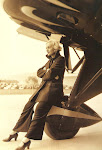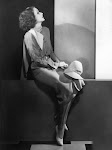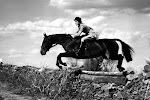By Starlight Reporter
Geraldine Doyle, the woman featured in the iconic WWII-era "Rosie the Riveter" poster above, has died at age 86. This image would eventually become the central face of Rosies everywhere and serve as the rallying cry for an entire social movement."
Rosie the Riveter was one of the most widely known personas of the 1940s. With her hair in a polka dot kerchief, sleeves rolled up, and a positive set to her jaw and eyes, Rosie could never be taken for granted. She had a can do attitude, feminity, beauty and yes, sex appeal.
This Rosie the Riveter poster model was never named Rosie, nor was she a riveter. Rosie was actually Mrs. Doyle who worked at a metal factory.
Why a Rosie the Riveter Poster?
At the government's request, The Ad Council, created the legendary iconic Rosie the Riveter to encourage women to serve America at work during WWII, not as nurses or secretaries, but in factories. As the War progressed, more and more planes and artillery became increasingly in demand. Manufacturers' buildings became munitions factories for producing weapons of war. Men, who had performed in the factories making munitions were now serving on the front battle lines and in short supply on the Homefront. How could the war be won without weapons?
Women were the key answer to step in to fill men's traditional roles in the factories. However, before women could begin their very important work in the factories, they had to be convinced of the importance of such an undertaking. The campaign to encourage women to take on traditionally male jobs focused on the main theme of patriotic duty. The campaign message was clear: you can work a man's job, and keep your femininity. Rosie the Riveter posters soon followed. "We Can Do It" blazoned alongside other war slogans, such as "We Can't Win the War Without Them," and paid tribute to women giving due honor for working on the home front.
The ad campaign proved convincingly seductive to American women. Women were impassioned by the call of their country. They were compelled to support their American men who lay their lives down for peace against the atrocities of war. Answering the call with no faint heart, women proved themselves capable with astounding vigor and stamina. They fulfilled the call to work, not only in factories, but in vacant occupations, traditionally male oriented.
Rosie represented the newfound strength of the 18 million American women who worked during the war and afterward became a figure of the female contributions and power with a can do attitude. Rosie the Riveters across the nation answered the call to serve their country, flawlessly, capably and even against all difficult and dangerous circumstances. In many cases the female workers supassed expectations, particularly, when the job demanded dexterity, detail, or persistence.
Vintage Allies (VAV!) adds a caveat to this story. Rosie was not the only working girl to benefit from her status as factory worker. Photographs of women engaged in their duty serving the country, posing diligently aside machines, were published in newspapers and magazines. This unfailing loyalty and bravado was sent to the boys on the warfront boosting their morale, and showing them what they were fighting for~ Family, Freedom, and Truth which is the American victory cry, in the greater part.
Every woman, on the Homefront, who was or wasn't represented in print as Rosie The Riveter wins the hearts of Americans everywhere. We thank Rosie The Riveters today for their extraordinary service and will forever and a day remember these women in the American book of Unforgettable Heroines.
In the span of those tumultuous few short years during WWII, Rosie The Riveter was never needed more. She is a venerated, war hero. Please know that she served her duty well and returned home with an honorable discharge. Today, we honor those Rosie the Riveters for their vast contributions to the war and for blazing new trails in gaining respect and opportunities for women. For more on WWII Front to Homefront, Gettysburgs' Greatest Generation is a non-profit foundation offering a valuable and reliable source of information.
What kind of woman are you when it comes to living life to the fullest?
Redd Evans and John Jacob Loeb wrote a "Rosie the Riveter" song in 1942:
She's making history,
Working for victory,
Rosie the Riveter.
Keeps a sharp lookout for sabotage,
Sitting up there on the fuselage.
That little girl will do more than a male will do"
Rest in Peace. Job well done~Starlight Reporter
For more information on the history of World War II, Front to Homefront: Gettysburgs' Greatest Generation
Special Thanks to Vintage Allies (VAV!) Article written by Starlight Reporter
Note: Norman Rockwell's Rosie Pictured Above
On May 29, 1943, Norman Rockwell's Saturday Evening Post cover was his version of Rosie. Please note the patriotic theme and background, the attributes of strength and feminity. You'll see Rosies' penny loafers rest casually on a copy of Adolf Hitler's Mein Kampf, a magazine article.
































No comments:
Post a Comment